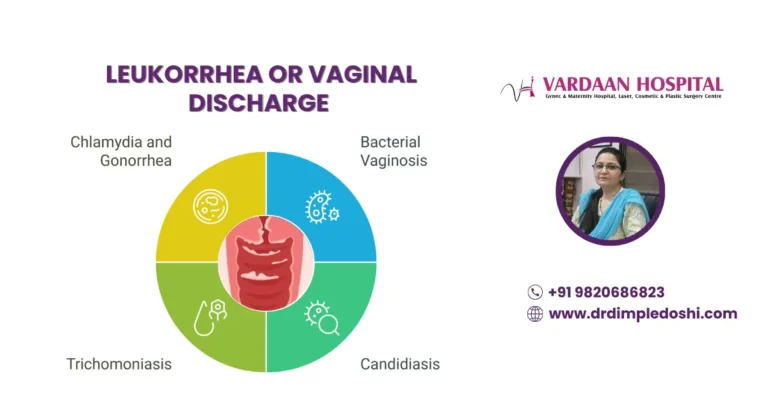Effective Leukorrhea Treatment in Goregaon West, Mumbai
Home » Leukorrhea

Overview of Vaginal Discharge and Leukorrhea
Normal vaginal discharge may be thin and watery or thick and sticky. It is usually clear or white in color, odorless, and not associated with itching or pain. In contrast, abnormal vaginal discharge, known as leukorrhea, is a common concern for women during their reproductive years. It can cause discomfort, distress, and affect daily life.Symptoms of Vaginal Discharge or Leukorrhea
- Yellowish, greenish, or curd-like discharge with or without a foul smell
- Persistent wetness and frequent need for panty liners
- Vaginal itching or burning
- Lower abdominal pain
- Burning during urination
- Pain during sexual intercourse
Causes of Vaginal Discharge or Leukorrhea
When is Discharge Considered Normal?
- Neonatal discharge due to maternal hormones
- Hormonal changes during puberty
- Increased discharge during pregnancy
- Mid-cycle ovulatory discharge
What Causes Abnormal Vaginal Discharge?
- Bacterial Vaginosis
- Candidiasis (Yeast Infection)
- Trichomoniasis
- STIs (Chlamydia, Gonorrhea)
Types of Vaginal Discharge
H3: Bacterial Vaginosis
- Fishy odor
- Thin, grey or green discharge
- Burning during urination
- Causes: Antibiotics, douching, unprotected sex, IUD
H3: Candidiasis (Yeast Infection)
- Odorless, thick white curdy discharge
- Severe itching, pain during sex/urination
- Causes: Antibiotics, vaginal gels, IUDs, poor hygiene
H3: Trichomoniasis
- Frothy, foul-smelling, yellow-green discharge
- Painful urination, vaginal burning and itching
- Sexually transmitted infection
H3: Chlamydia & Gonorrhea
- Pus-like discharge with urinary symptoms
- Painful urination
- Sexually transmitted diseases
How is Leukorrhea Treated?
Medical Treatment
- Antibiotics (Azithromycin, Metronidazole, Amoxyclav)
- Antifungal drugs (Fluconazole)
- Intravaginal pessaries
How Can Leukorrhea Be Prevented?
Key Prevention Tips
- Maintain safe sexual practices
- Avoid douching and harsh cleaning agents
- Treat and protect sexual partners
- Use cotton undergarments
- Avoid vaginal sprays, perfumed products
- Take probiotics when using antibiotics
- Wipe front to back after using the toilet
- Avoid tight clothing for extended periods
- Maintain hygiene after intercourse
- Shower daily and pat dry
Are Vaginal Washes Helpful?
Vulval cleansing with pH-balanced, hypoallergenic washes can reduce recurrence of bacterial vaginosis. These are recommended for women with recurrent odor or discharge.
What is the Cost of Leukorrhea Treatment in Mumbai?
The cost of leukorrhea treatment may vary based on the severity and type of infection. On average:
- Consultation Charges: ₹800 – ₹1000
- Lab Tests (e.g. Culture, Swabs): ₹2000 – ₹5000
- Medication (Antibiotics/Antifungals): ₹500 – ₹2000
Who is the Best Doctor for Leukorrhea Treatment in Goregaon West?
Dr. Dimple Doshi at Vardaan Hospital is recognized as one of the best gynecologists for the diagnosis, treatment, and prevention of leukorrhea. Her approach includes both medical management and lifestyle guidance for long-term relief.
Which is the Best Hospital for Leukorrhea Treatment in Mumbai?
Vardaan Hospital in Goregaon West is well-equipped with modern diagnostic tools and experienced specialists for comprehensive gynecological care, including treatment for leukorrhea.
Frequently Asked Questions (FAQs)
Q1. What is leukorrhea and is it normal?
Ans. Leukorrhea is a vaginal discharge that may be white or yellowish. While some discharge is normal, foul-smelling or colored discharge indicates an infection.Q2. Is leukorrhea harmful?
Ans. If left untreated, it can cause discomfort, infections, and complications in reproductive health.Q3. What causes leukorrhea?
Ans. It may be caused by bacterial, fungal, or parasitic infections, hormonal changes, or STIs.Q4. How is leukorrhea diagnosed?
Ans. Through pelvic examination, lab tests (smears, cultures), and STI screening.Q5. Can leukorrhea be cured permanently?
Ans. Yes, with appropriate treatment and preventive measures, it can be completely managed.Q6. How can I prevent leukorrhea?
Ans. Practice good hygiene, use protection during intercourse, and avoid harsh feminine products.Q7. Which doctor should I consult for leukorrhea in Mumbai?
Ans. Dr. Dimple Doshi at Vardaan Hospital, Goregaon West, is a leading expert in women’s reproductive health.ICD-10 and CPT Codes for Leukorrhea
ICD-10 Codes
- N89.8 – Other specified disorders of the vagina
- N92.1 – Excessive menstruation with irregular cycle
- N95.0 – Postmenopausal bleeding
CPT Codes
- 99201–99215 – Office visits
- 87270 – Cervical/vaginal smear
- 87110 – Aerobic culture
- 87491 – Chlamydia test
- 87591 – Gonorrhea test

